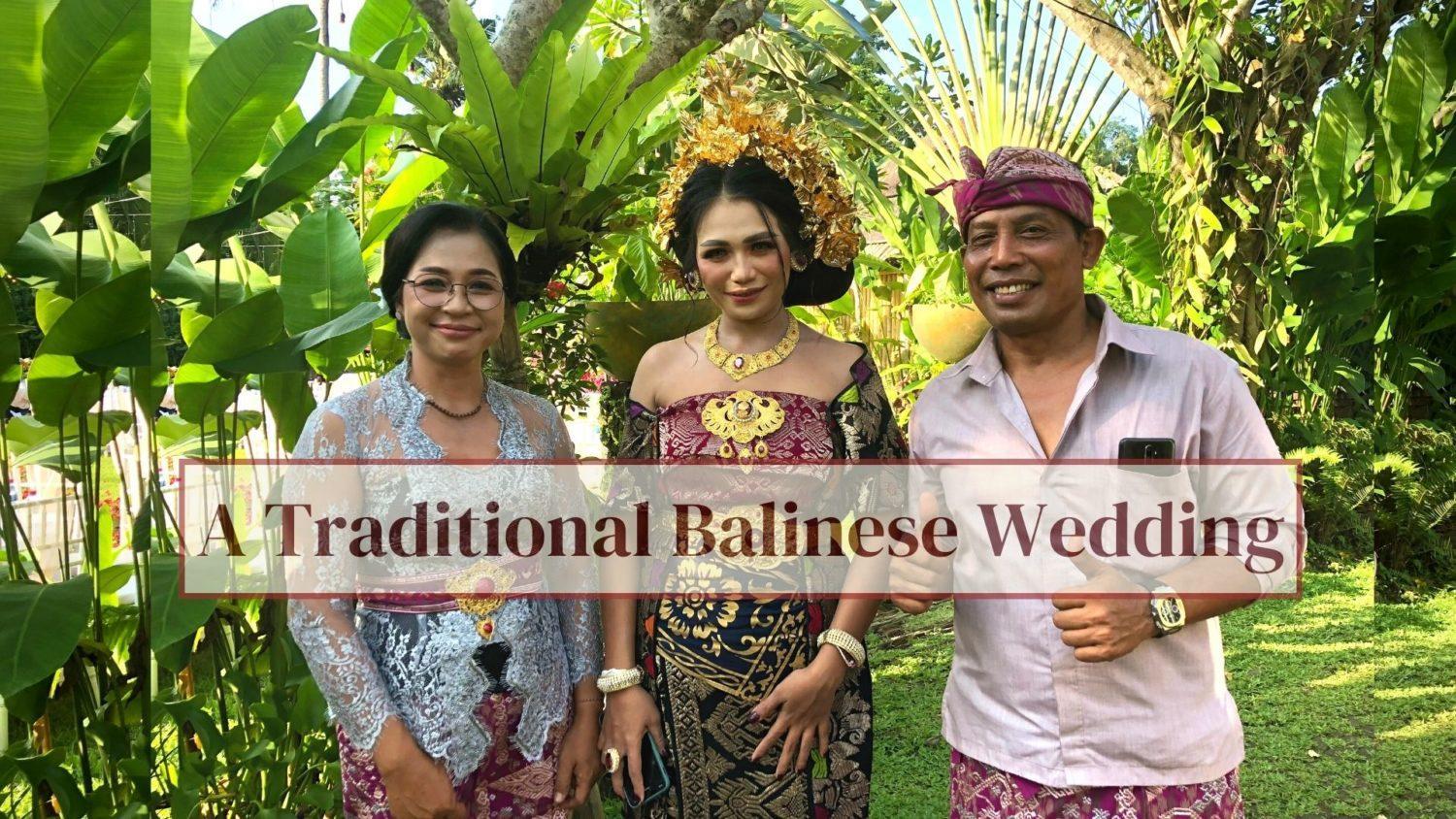
If you’ve never been to a WEDDING in Bali, prepare yourself. Balinese marriages are serious business. Once you finish this ceremony, the bond is intended to last many lifetimes. Marriage is considered one of our most important duties, a turning point as two people enter the second phase of their lives. Through marriage, we accept the larger responsibilities of adulthood. We pay our debts to our ancestors by procreating good children. We ensure the continuation of the cultural family lineage.
Hindu weddings are a process with numerous rituals that can take days to traverse. Every custom and practice in a wedding ceremony has deep philosophical and spiritual significance. Balinese Hindu communities follow these ritual steps carefully to continue their unique traditions.
This year our close community had FIVE weddings in ONE WEEK! That’s because the most AUSPICIOUS time for a wedding is in the springtime after New Year. Balinese New Year is Nyepi, which happens at the March equinox, the day after the new moon. On this special date, the day and night are of equal duration. Nyepi represents a massive purification of the entire world. Nyepi celebrations are famous in Bali. The festival begins with a frightening Ogre Ogre parade in the evening, after which every demon is burned in a huge fire, so that all evil in the world is destroyed. The following day is Nyepi, when all people stay home, there is no music, no food preparation, only quiet prayer within the private home of each family. In Bali, it is so quiet, even the internet is off.
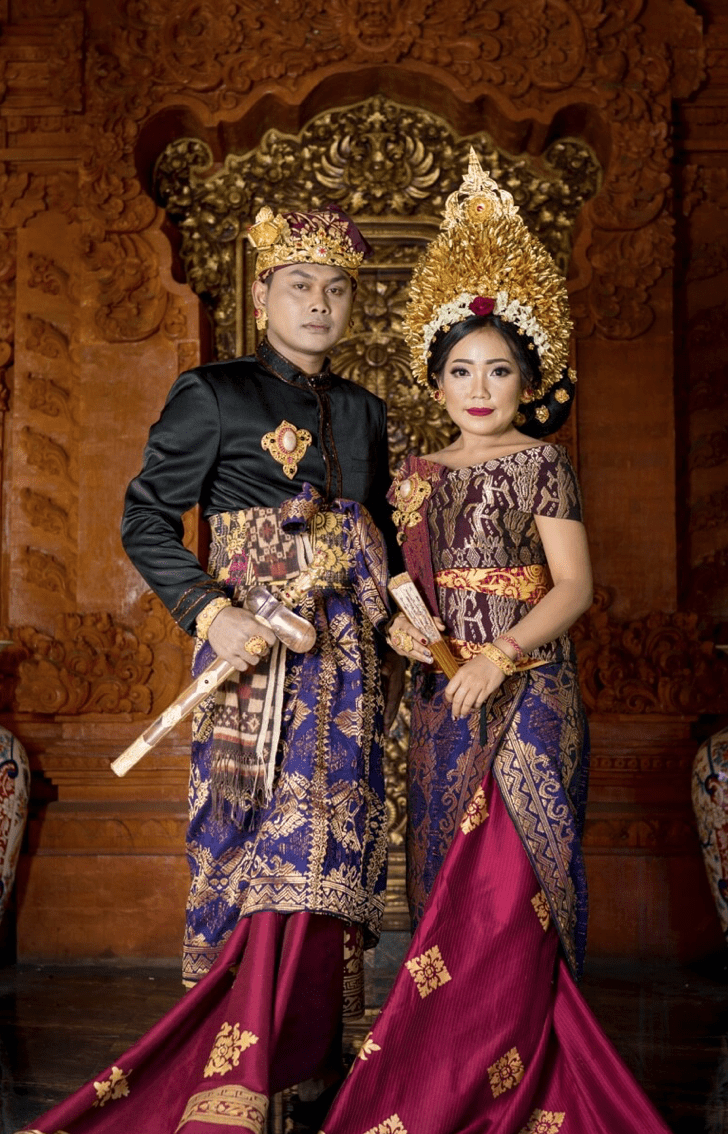
The few days after Nyepi are considered the absolute most auspicious time for a wedding ceremony. Because the world has just been cleansed, it is a good time to begin new things. A wedding is a sacred union of a man and a woman, to build a new life together. A traditional Balinese wedding has symbolic steps. Everyone in the family and community come together to celebrate the union. It is a beautiful site to see!
A Balinese Hindu wedding is very different from an Indian Hindu ceremony, although they have many common features. Bali traditions are a unique combination of Indian and early shamanic culture. Hinduism came to Indonesia around the 2nd century CE with Indian traders, and it peaked in the 14th century CE with the great Majapahit kingdom that covered all of Southeast Asia. After Islam dominated the island of Java, the Hindu Majapahit court dissolved in 1527. All the Hindu loyals migrated to Bali, which is now the last Hindu island in Indonesia.
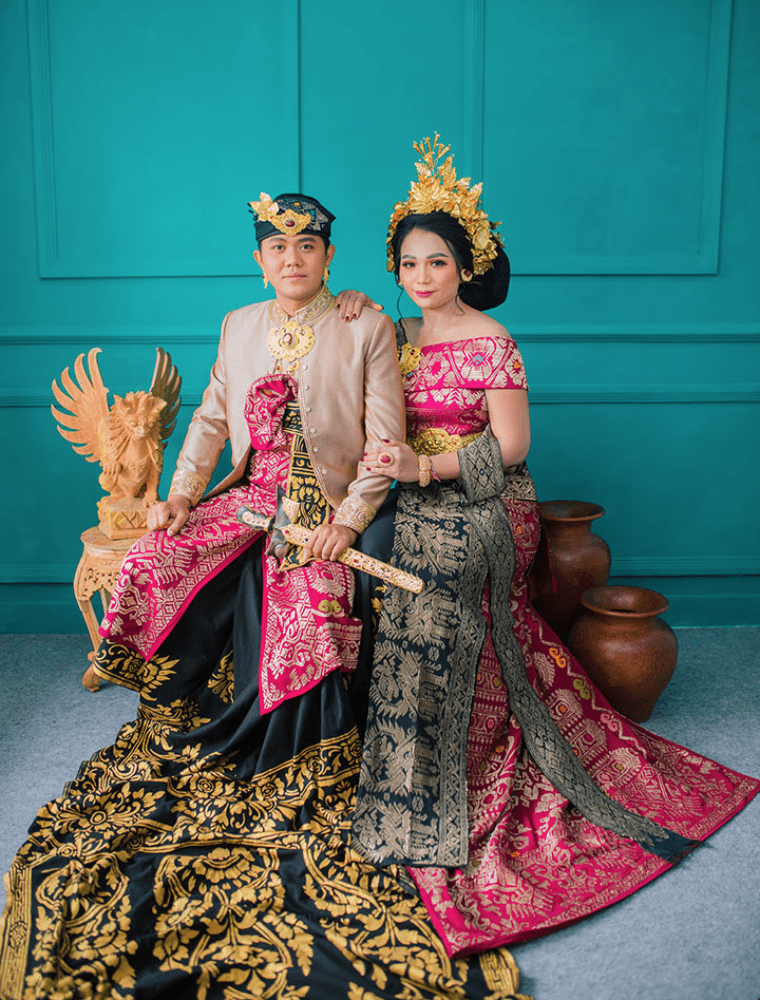
We were invited to our beautiful friend Mira’s traditional wedding at her home. Immediately after, our friend Komang Agus and his beautiful wife Indah celebrated their wedding in a traditional Balinese ceremony. Then Mira had her second wedding here at Keramas Sacred River Village. It was a modern Western wedding complete with cake and fire dancers!
Then our beautiful friend Putu got married as well. Each wedding was unique, and they all followed this traditional format. We got to see all the steps, the preparation, and photographed these events. A traditional Balinese wedding is somewhat Hindu, and contains local shamanic influence. It is a ceremony that essentially prepares a man and a woman for a huge change in their lives, and teaches them how to function as responsible adults in the world. What a concept!
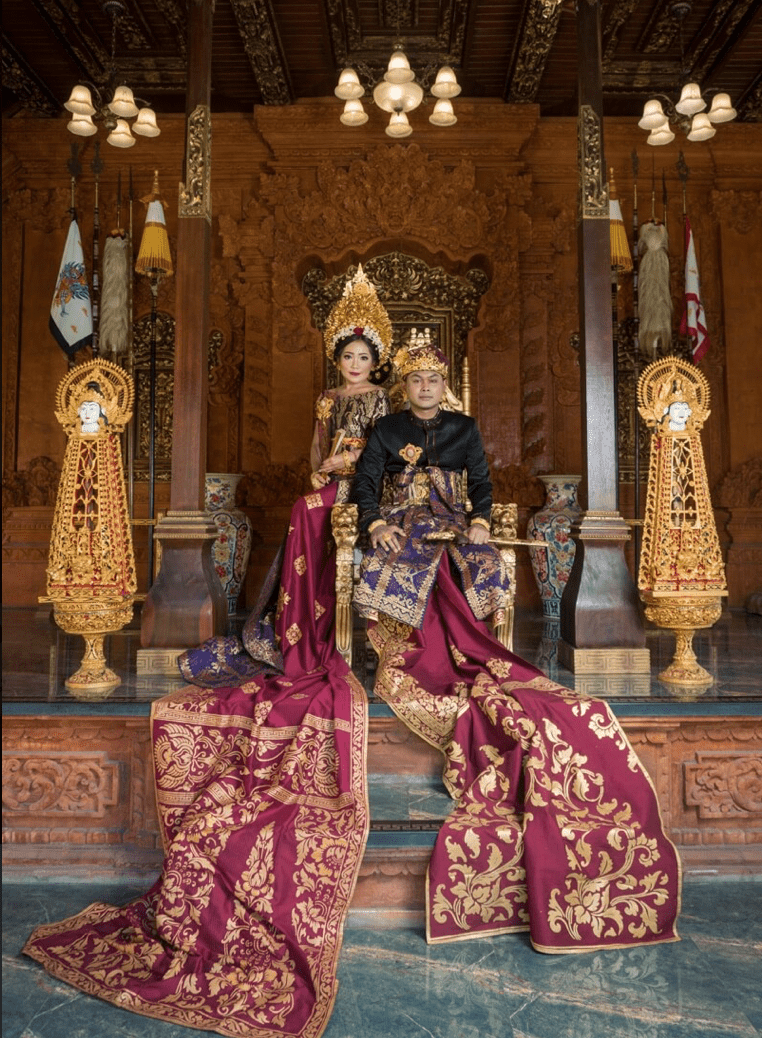
There are 12 steps in a Traditional Balinese Wedding
- Masedek, The Proposal – Realization of Marriage Planning
- Ngekeb, Private Bath and Preparation for Bride
- Ngungkab Lawang – Opening the Door – Groom Brings Bride Ceremonially to his Home
- Wedding Day – Make-up, Dress, Go to Temple, Welcome Blessing by Serati Ladies
- Mekala-kala – Ask Permission of Mother Nature for Union of Man and Woman
- Madagang Dagang – Buying, Selling, Fertility Blessing
- Nuwek Tikeh Dadakan – Groom Pierces the Coconut Leaf with Symbolic Sword
- Entering the Gates to a New Life, Planting Cassava, Creating a Home
- Mewidhi Widana – Sacred Blessing with Priest
- Masakeb – Stay inside the house together
- Sungkem – Asking for Forgiveness, Honoring Both Parents, Sharing Food
- Nunas Panugrahan – Bride and Groom Asking Prayers from Community
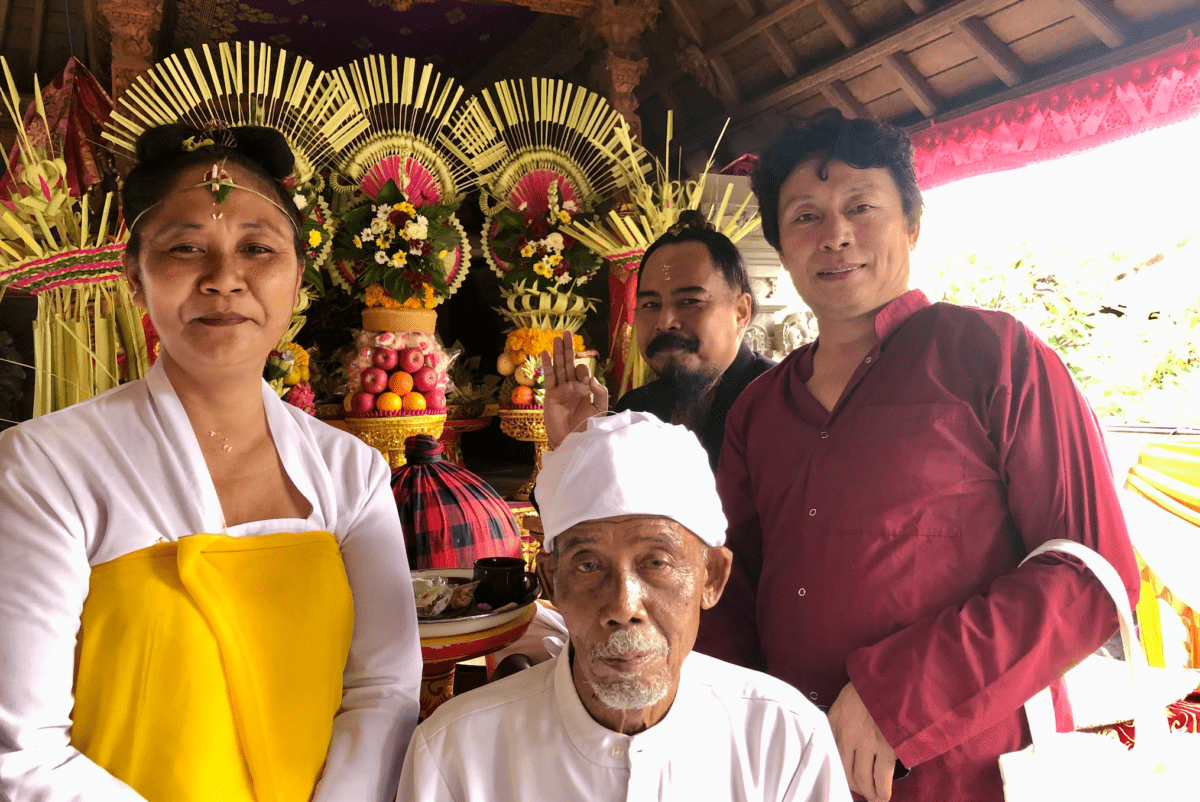
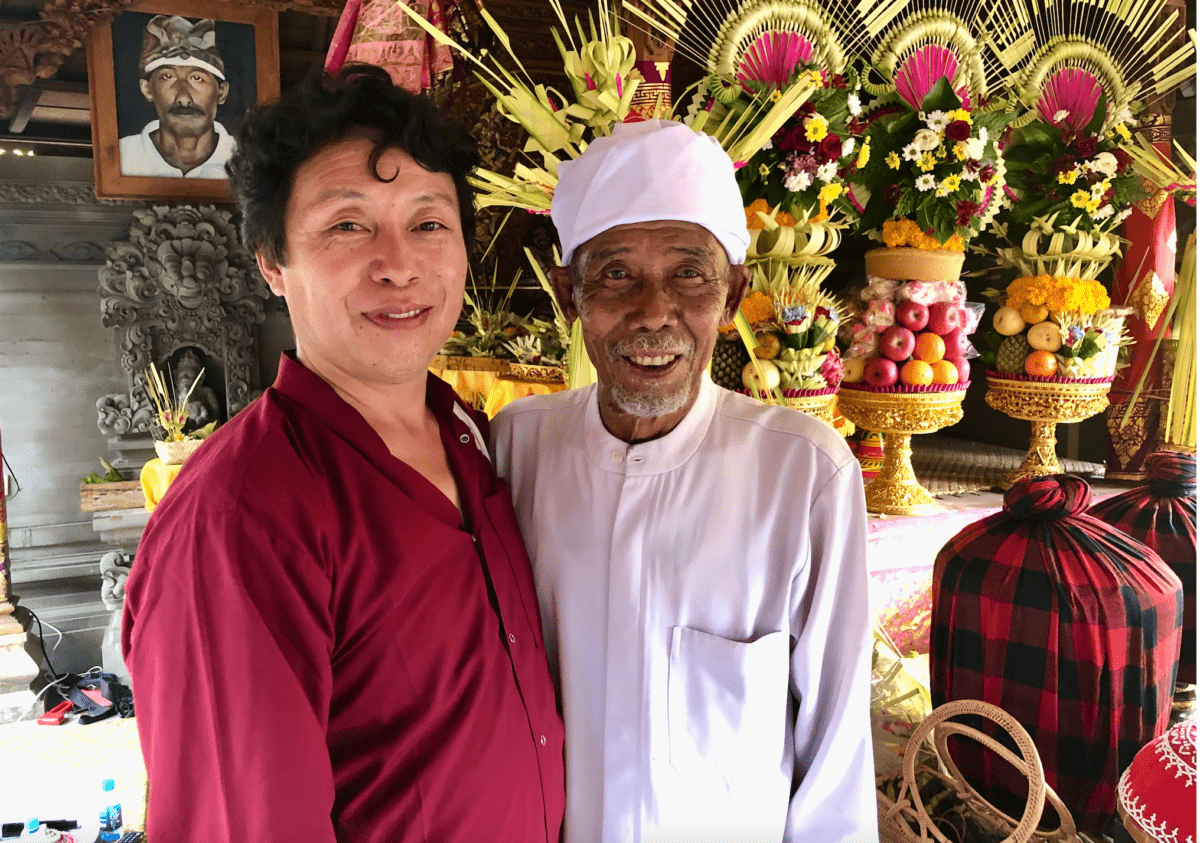
1. Masedek, Proposal – Realization of Marriage Planning
On this day the man comes to the woman’s home to state his willingness to propose to the woman in according to Balinese tradition. Both the groom and bride’s families come together at the bride’s home. They discuss the details until both families from the man and the woman agree to do a wedding ceremony. The day I did the Masedek was on March 4.
Good timing is a way to have a blessed, smooth, or unlucky marriage. A good date is usually determined by the groom’s family. We discussed the date of the wedding, to be immediately following Nyepi. We chose the program for the ceremony, and the preparation to do. We had chosen March 7th as the date for the wedding.
At that time, we exchanged gold rings. My name is inscribed in her ring. Her name is engraved in my ring in the Bahasa Indonesian language.
At the meeting we decided to make it a one-day ceremony starting from 5 o’clock in the morning until 11 o’clock in the evening. This is a very long ceremony. In our case we chose to do it all in one day, although it is traditionally supposed to be a seven-day ceremony. We had to take into account both our work schedules and the venues available. We decided to make it a simple one-day event.
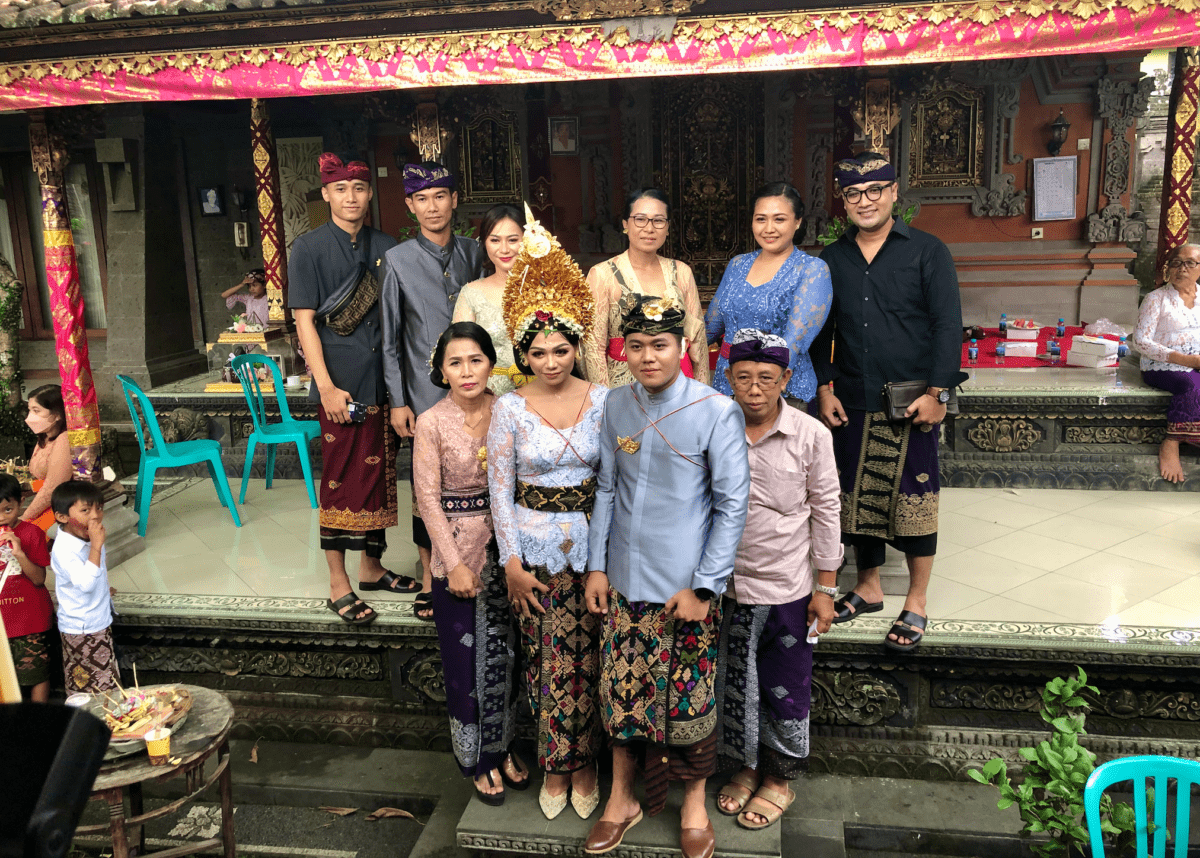


2. Ngekeb, Private Bath and Preparation for Bride
The Ngekeb ceremony is carried out by bathing and washing the hair of the bride in her home with a special scrub. This scrub is made from a mixture of peacock leaves, ylang flowers, turmeric, and mashed rice. This scrub is also smeared all over the bride’s body in the afternoon.
After that, the bride enters the bridal room which has been filled with offerings and she is not allowed to leave it until the groom picks her up. When the groom arrives at the bridal chamber, the woman must be covered with a voile cloth from head to toe. This ngekeb ceremony means that the woman has buried her past deeply and is ready to open a new chapter of life with her future husband.
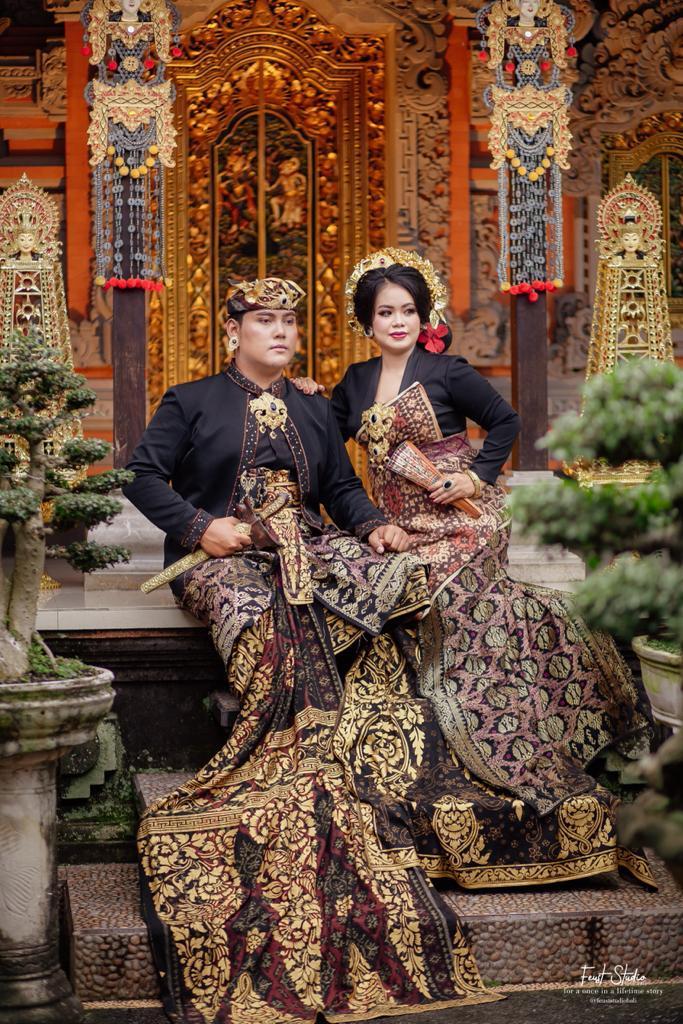
3. Ngungkab Lawang – Opening the Door – Groom Brings Bride Ceremonially to his Home
This means opening the door to the future. This ceremony is carried out by picking up the bride and her bridesmaids by the groom and his attendants. The groom recites Vedic verses and the bride responds with her Vedic verses throws betel leaves to remove any evil forces in the ceremony. This step in the marriage offers respect to the bride’s family and hope that they will become a harmonious married couple.
After the marriage proposal the man invites the woman to go with him to his house. She packed one piece of luggage and left her family ceremonially forever. But in our shortened version, we didn’t go to my home. Instead, we went directly to the venue, Tamang Buddha, at Keramas Sacred River Village where the ceremony was to be held.
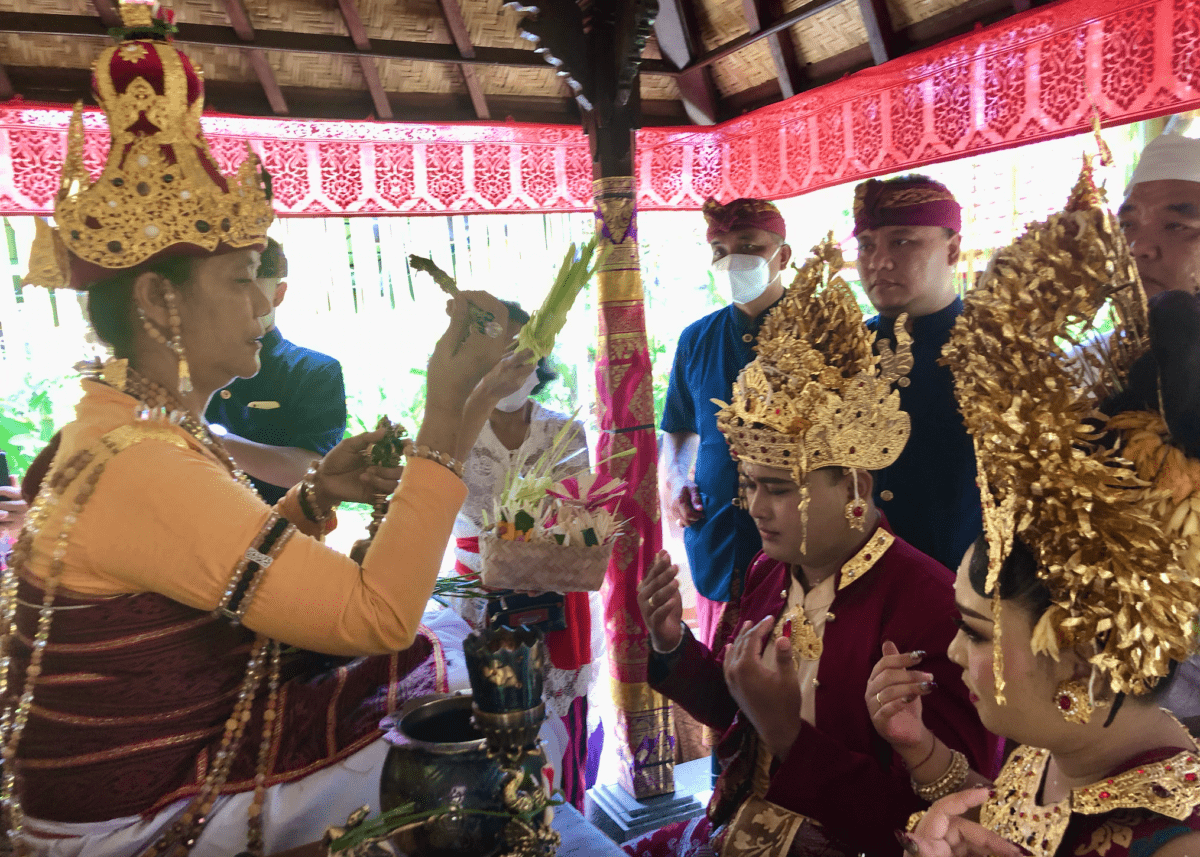
4. Wedding Day – Make-up & Dress, Go to Temple, Welcome Blessing by Serati Ladies
On the day of the wedding, we both woke up at 2am. We hired a professional beautician, who came to the groom’s house. This may take many hours. She started with hair, then face make-up, then the dress, and last the headdresses. Fours hours later, at 7am we were ready to leave. Some weddings go to the family temple, however in our shortened version we went directly to Taman Buddha venue.
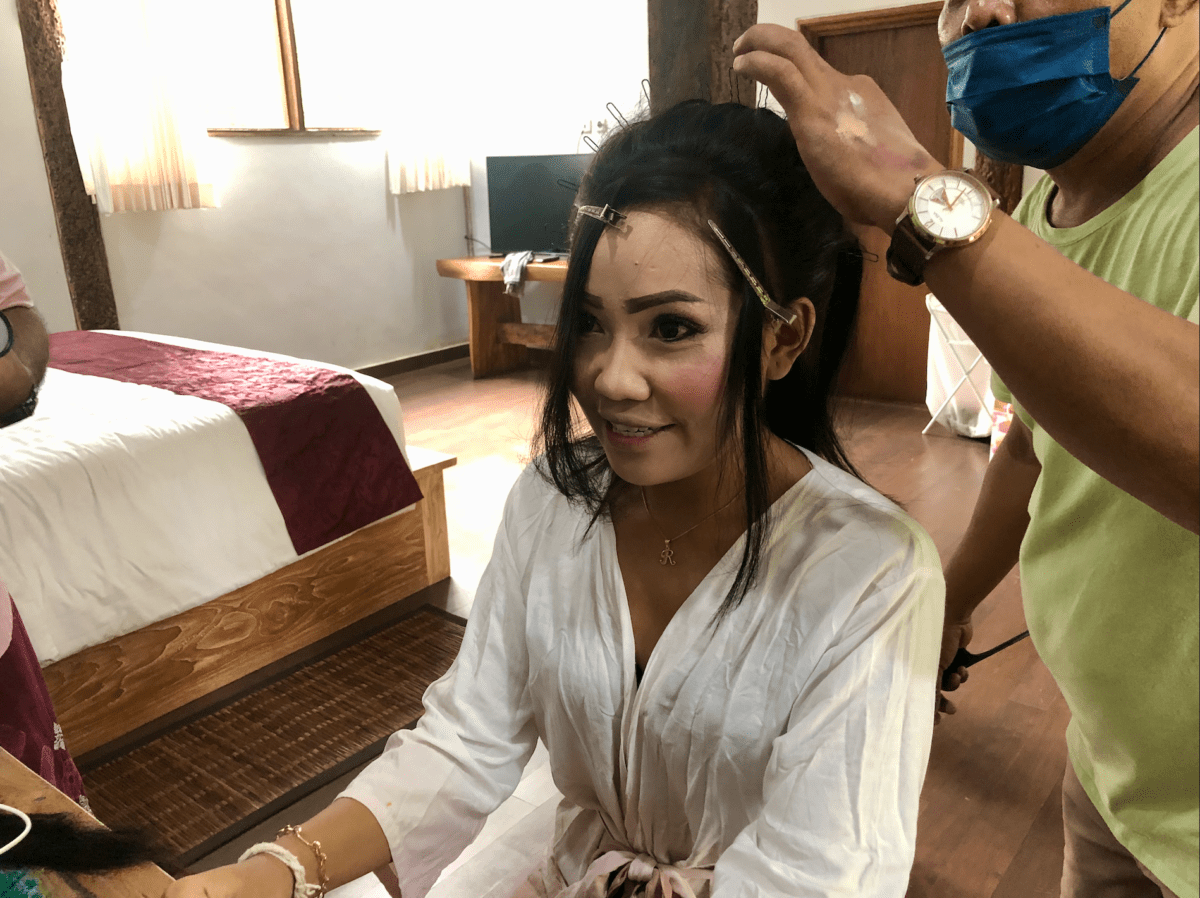
Our celebration began with a traditional Banten Pawiwahan at Taman Buddha. We came in a car convoy, so that we arrived together at the front of the gate of Taman Buddha, where there is a huge statue of the Buddha.
We were welcomed by the Serati ladies of the ceremony. These are usually woman who are experts in ritual offerings. The marriage altar faces East toward the rising Sun. Seratis make offerings on the ground and on the altar. We had to step up onto the shrine area that is the prayer place where the ceremony was to take place. We waited a short time, about 30 minutes for the priest to come to the altar. We use a table for this part. The bride and groom first do a blessing in the ground.
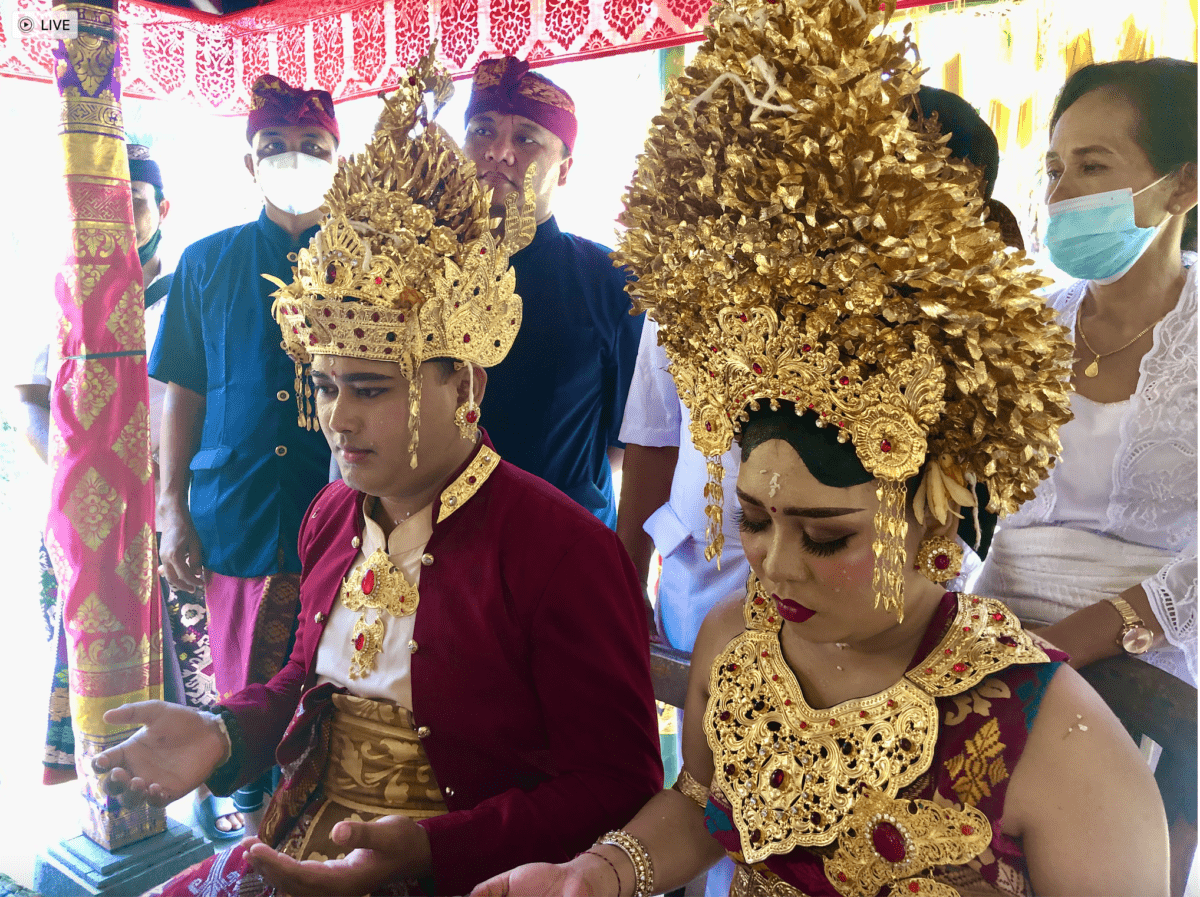
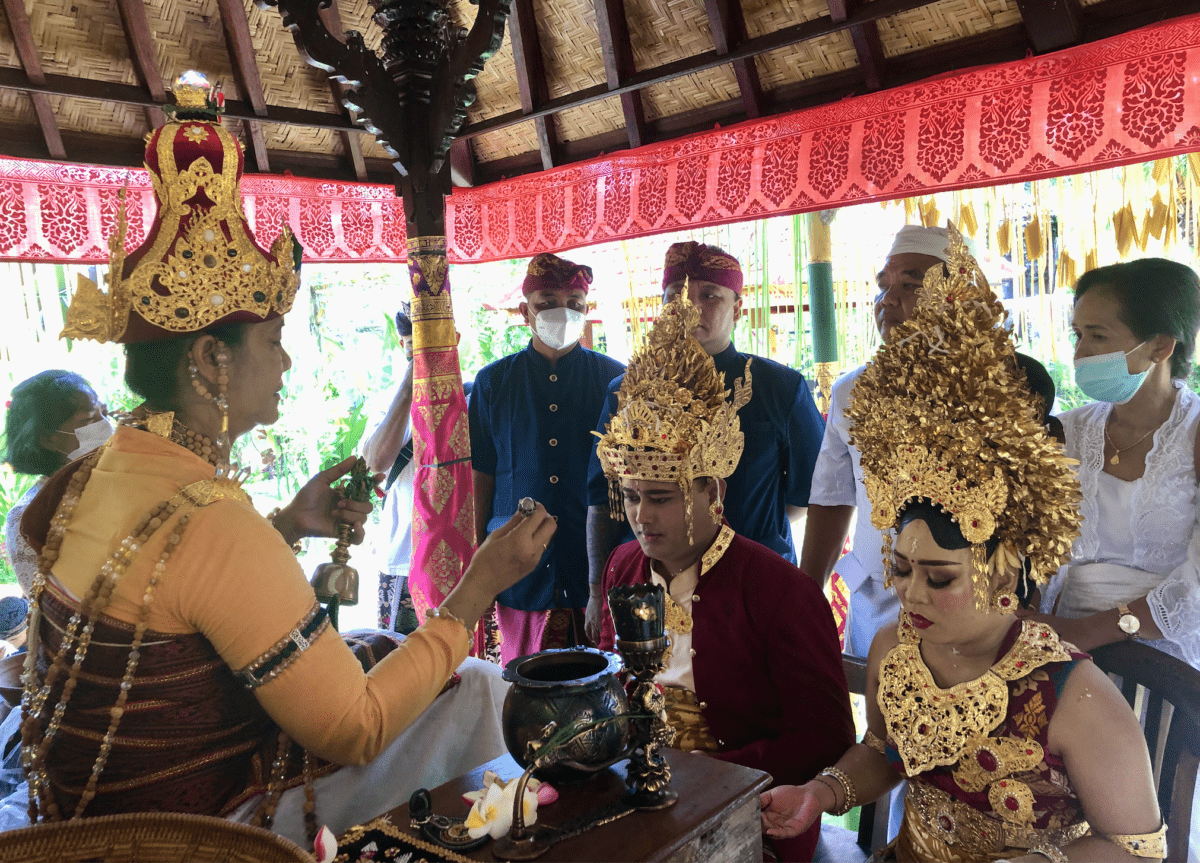
5. Mekala-kala – Ask Permission of Mother Nature for Union of Man and Woman
The next step is the Mekala-kala, is a blessing to unify the two great polarities. The groom and bride pray to receive blessings from Mother Earth. There are two offerings put on the ground to connect the positive and negative, the male – female polarities.
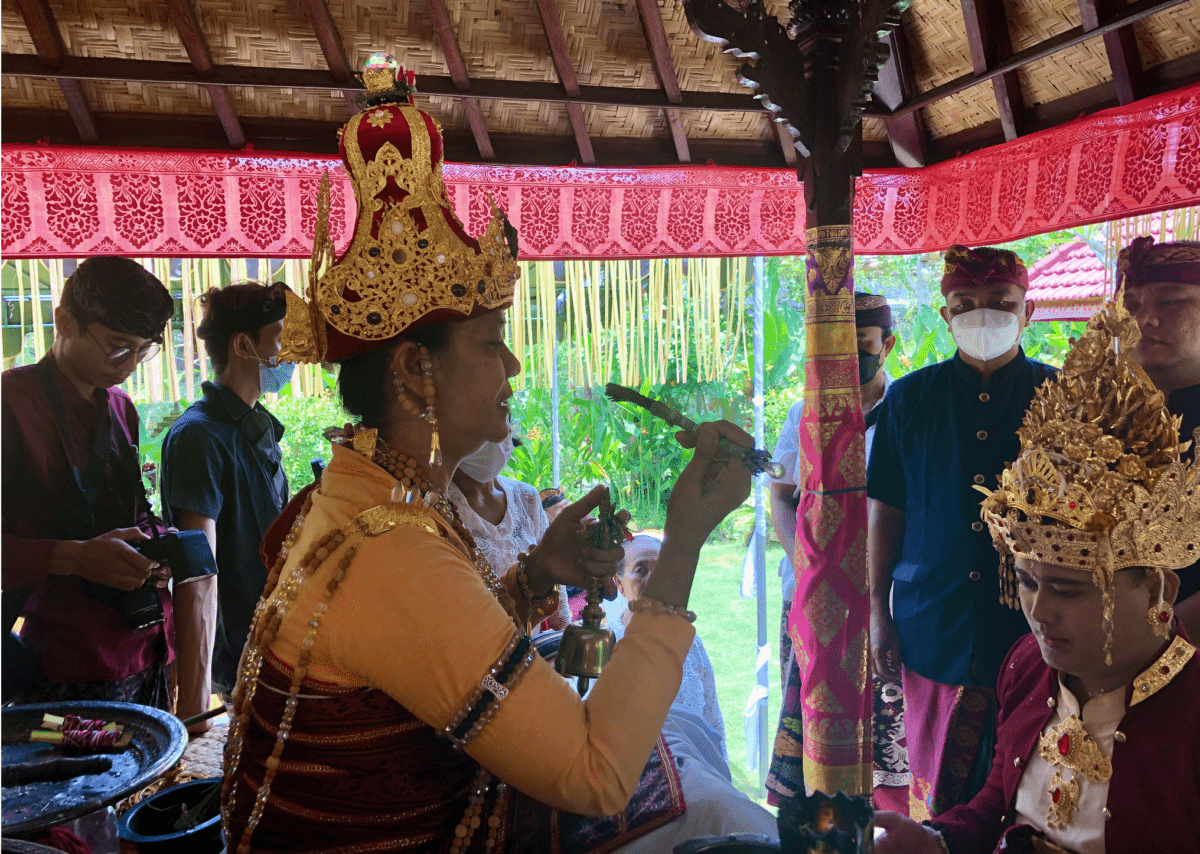
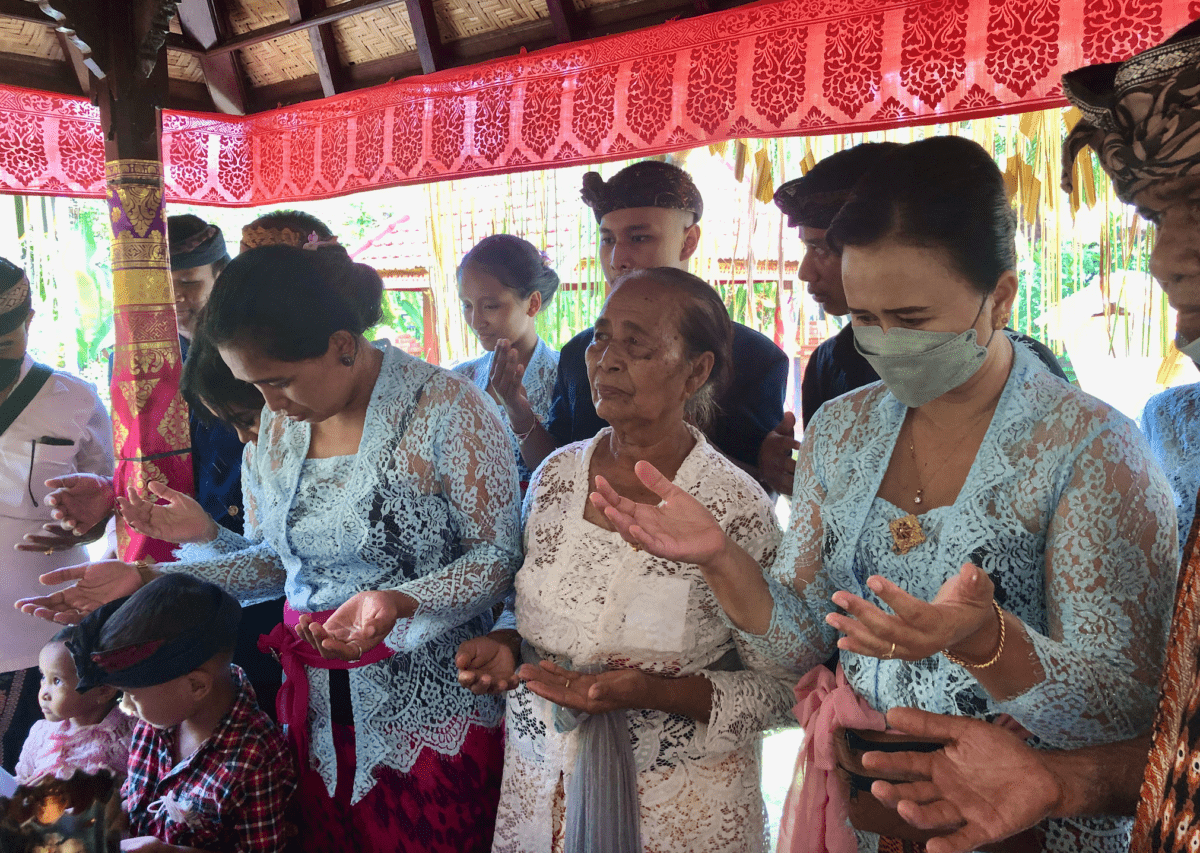
6. Madagang Dagang – Buying, Selling, Fertility Blessing
In this part the bride and groom pretend to buy and sell. They haggle prices, and interact with the wedding guests. When haggling leads to payment, it will go into the coffer of their future home. In this ceremony the bride sits on a coconut until it breaks apart. This symbolizes the opening of fertility in the marriage.

7. Nuwek Tikeh Dadakan – Groom Pierces the Coconut Leaf with Symbolic Sword
Then the groom does what we call Nuwek Tikeh Dadakan, the union of male and female energy. The groom pierces a large coconut leaf with a zigzag sword. This means the yoni is penetrated by the lingam, the sperm, she is ready for an embryo.
8. Entering the Gates to a New Life, Planting Cassava, Creating a Home
Then the bride and groom walk along a path that is traversed by a little rope. They must pass through it and break the rope, which means they are breaking through the next step in their lives, and starting a marriage.
Then the couple ceremonially plant cassava. They take a small cassava sprout, dig a hole in the ground, and plant it in another place to symbolize growing food. In this way, they are building a life together. Their new life starts with the marriage, then planting a garden, gathering food, piercing the egg, cultivating land to live on, carrying groceries, having a house, honoring the parents, and doing home activities together. Then the couple gathers things to symbolize they are carrying groceries and bringing so many things into their new home, working together in harmony and cooperation.
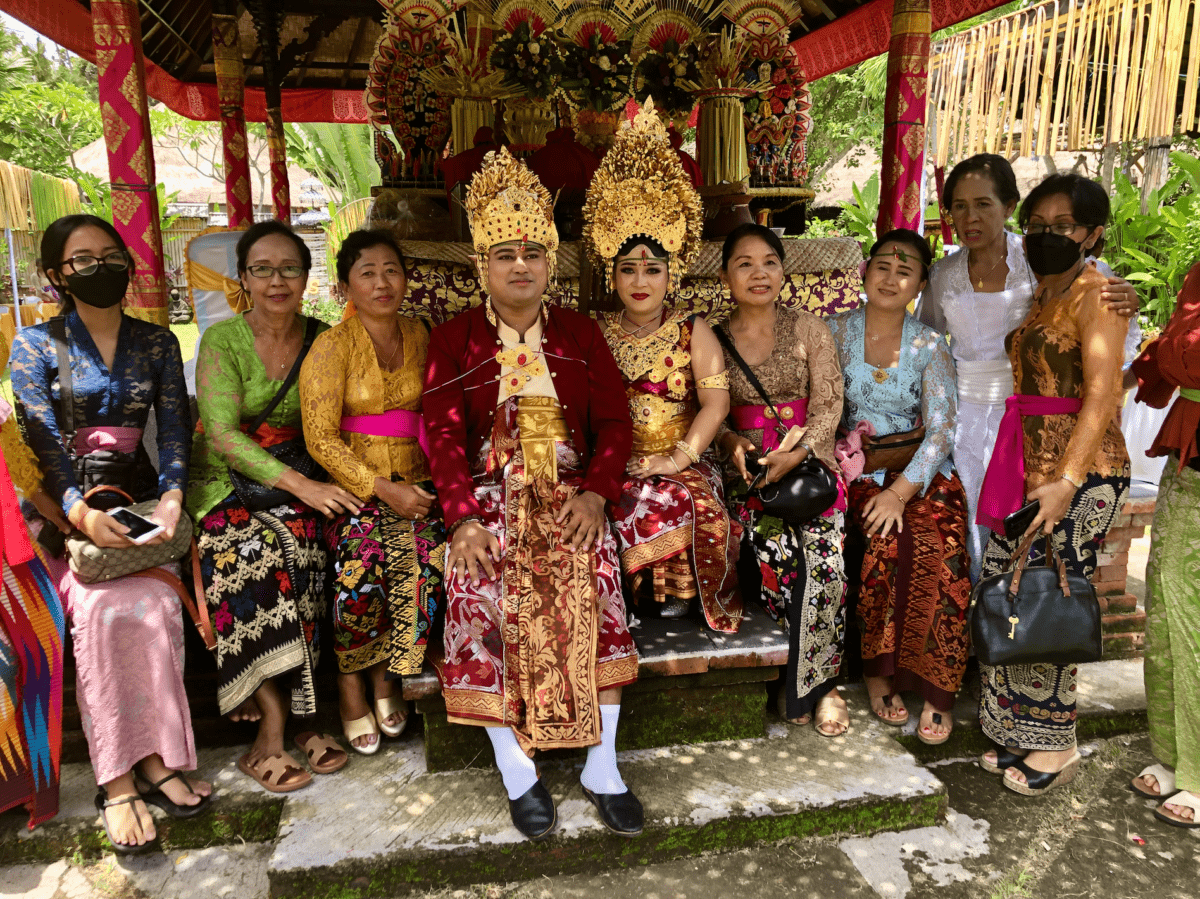
9. Mewidhi Widana – Sacred Blessing with Priest
The groom and bride come up to the altar by the priest. Offerings symbolize the cleansing of the body before moving up into higher levels of life. Then the couple goes to the altar to sit in front of the priest. Two main priests are used in the ceremony. One wears ceremonial dress and sits up at the high altar with the couple, chanting traditional prayers, and splashing blessings with holy water. The other priest wears white, and chants and directs the activities on the ground. He had a microphone and was able to explain to family and guests what they should do.
Then they do a prayer to the Gods, for the many manifestations of a happy marriage. They pray to the ancestors of both families. They offer prayers for both of them to have a happy life together, to honor their commitment to stay together.
The prayers take about two hours, as the priest recites them in ancient Javanese. Periodically the priest douses them with holy water to bless the union. Then the priest ties on each of them a strand of decorated grass around the head. And a cord tied around the body to indicate their commitment to a happy life.

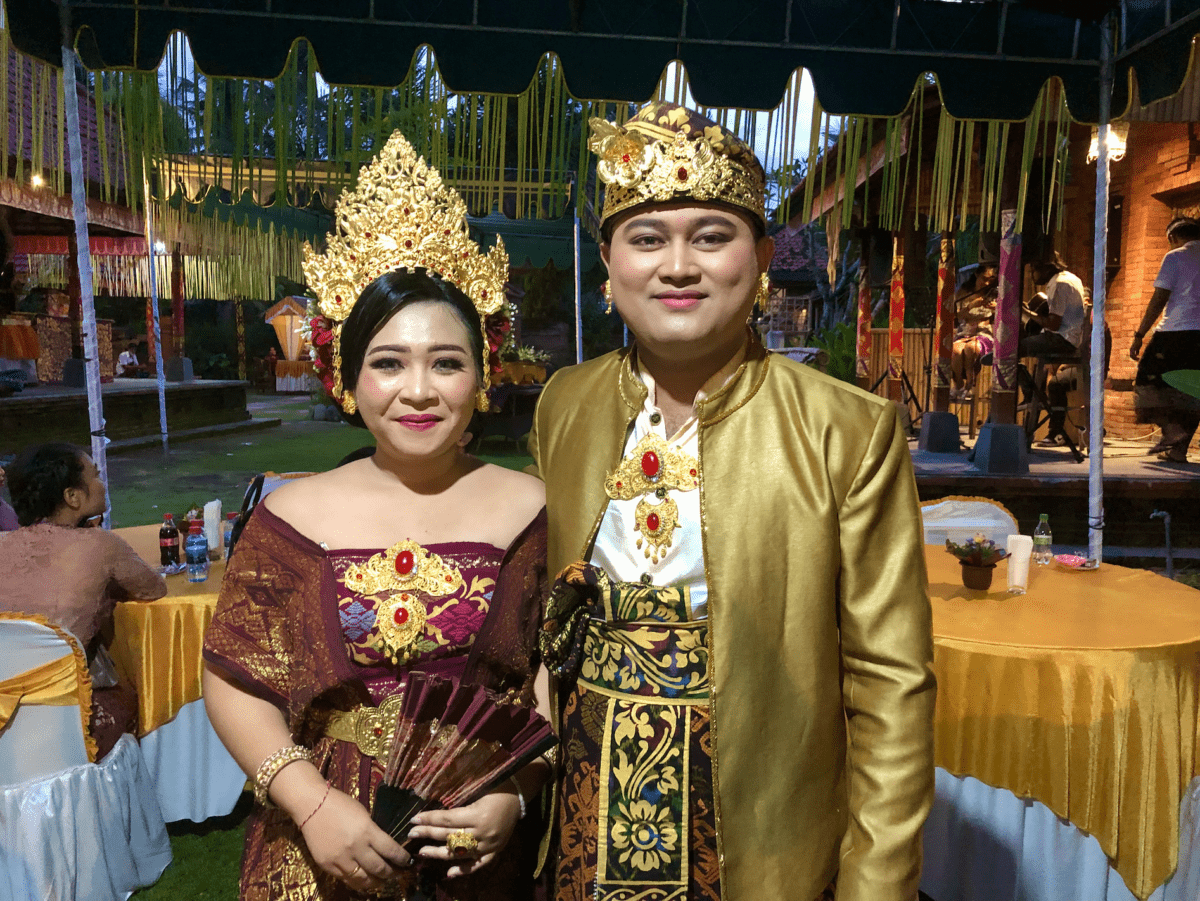
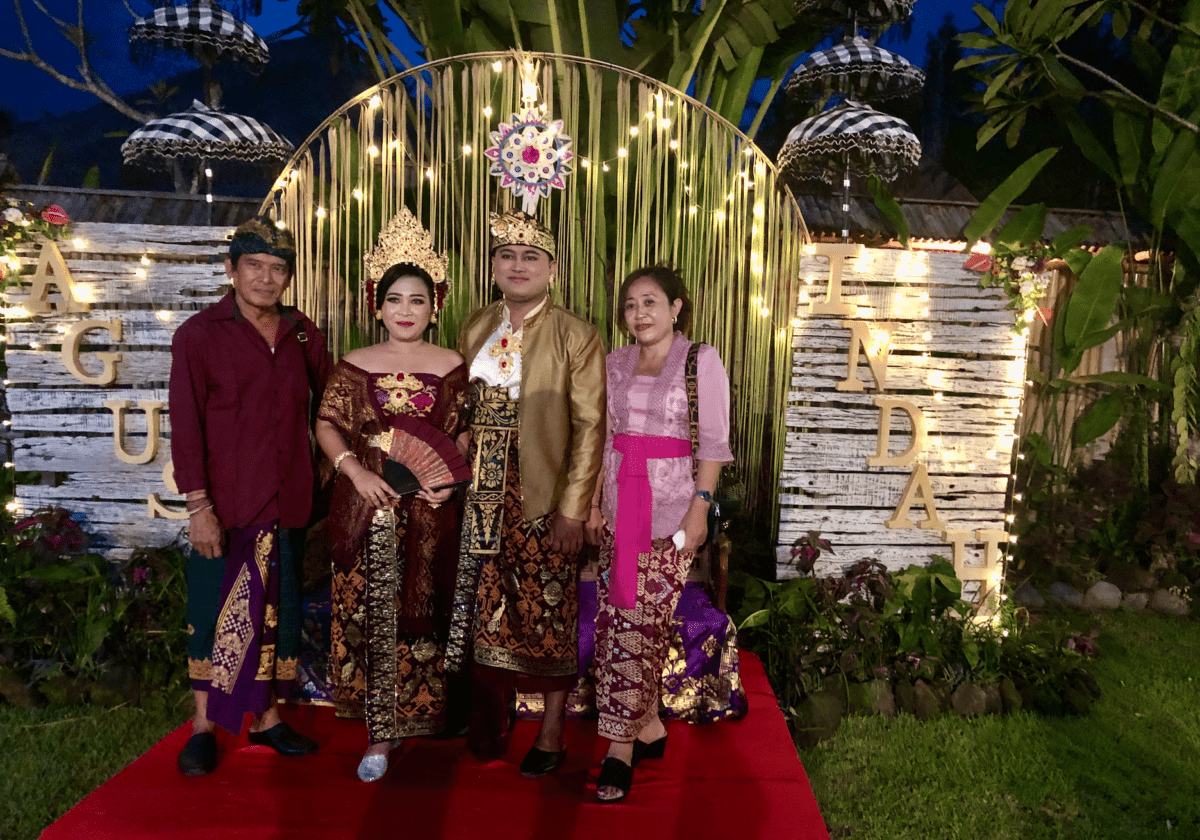
10. Masakeb – Stay inside the house together
Then the bride and groom go into a small ceremonial house where there is a huge bed. They were accompanied by a woman offering holy water from a flask. The guest will not see what happens on the bed in the little house, but we can guess! This is a beautiful symbol of coming together as a man and a woman. Then the family walks in a circle chanting and carrying offerings and the parents are seated on four chairs.
11. Sungkem – Asking for Forgiveness, Honoring Both Parents, Sharing Food
The bride and groom kneel before their parents, he before his, and she before hers. This is called “Sungkem” from Javanese. They honor their mother and father thank them for having them and raising them. The bride and groom ask forgiveness of their parents, for any mistakes, and embrace each one, as they begin their new life. Then the couple changes sides – the bride bows before his parents, and the broom before hers. They repeat the prayers of honor, gratitude, and acknowledging the new relationship. Then all six people stand up and embrace as a big family.
The priest asks the groom and bride to give each other food with a spoon. This consists of rice and meats from the offering ceremony.
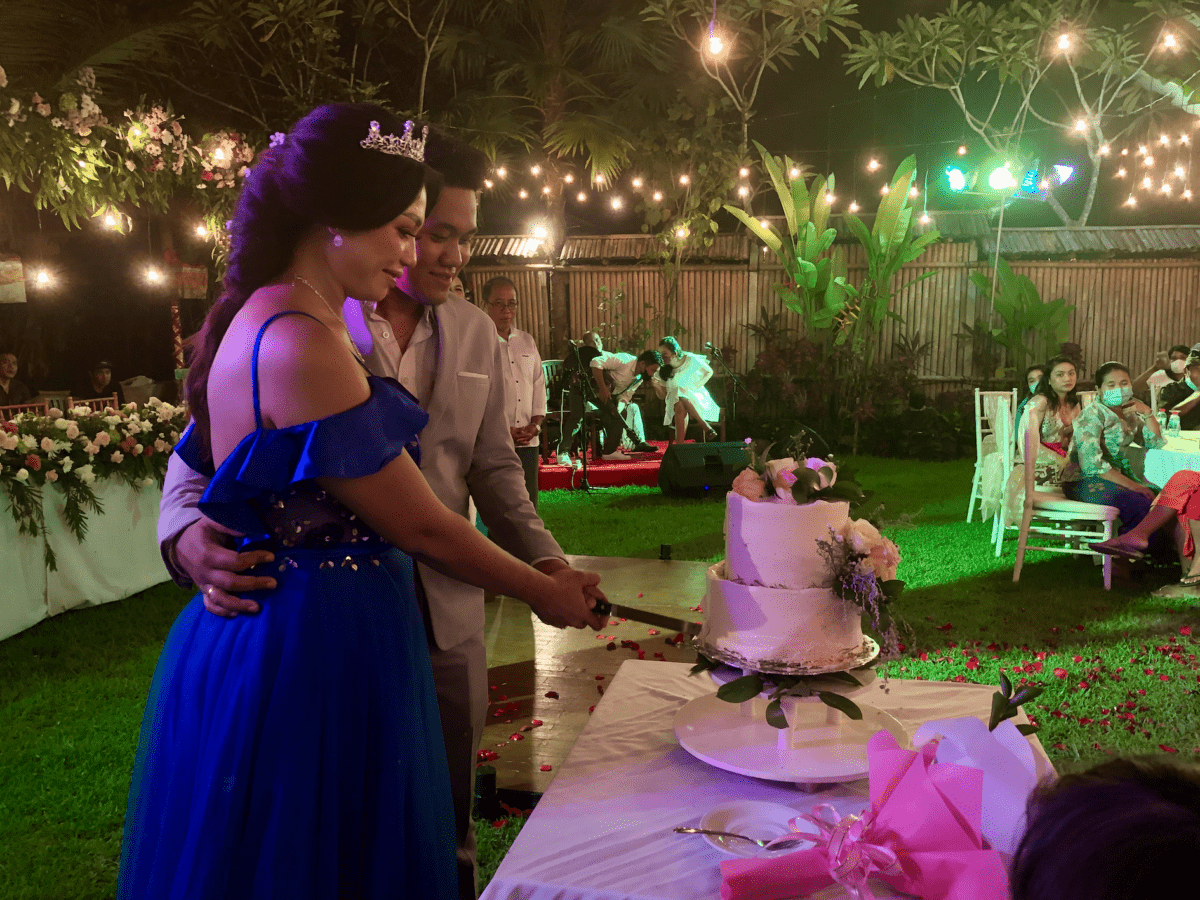
12. Nunas Panugrahan – Bride and Groom Asking Prayers from Community
Then the bride and groom come out of the altar area and stand, to allow the guests to line up and congratulate and speak to them. That is the end of the traditional ceremony. Then everyone goes to take a rest. And the reception could be later in the day. There will be more food, music, children, lots of activities and gathering of the extended family and friends.

The Wedding Ceremony is Finished
After the ceremony the couple can actually do the Masakeb, which means “to hide inside”. The couple stays at home together and do not go out for three days to a week. They do husband and wife activities together and build a life. Here at Taman Buddha, the couple can stay in the private villa by the ceremonial garden.
This is the basic traditional Balinese wedding. It normally lasts for six days. It could be changed if you are a very wealthy person or a king the decorations would be very sumptuous in a fancy place with thousands of guests. If you’re a simple farmer, it still takes six days, however it would be much simpler and close to home for the family and villagers. Each wedding is a little different.
A modern Balinese wedding would be different. It might include a cake, live music, a white bridal dress, and Western suit for the groom.
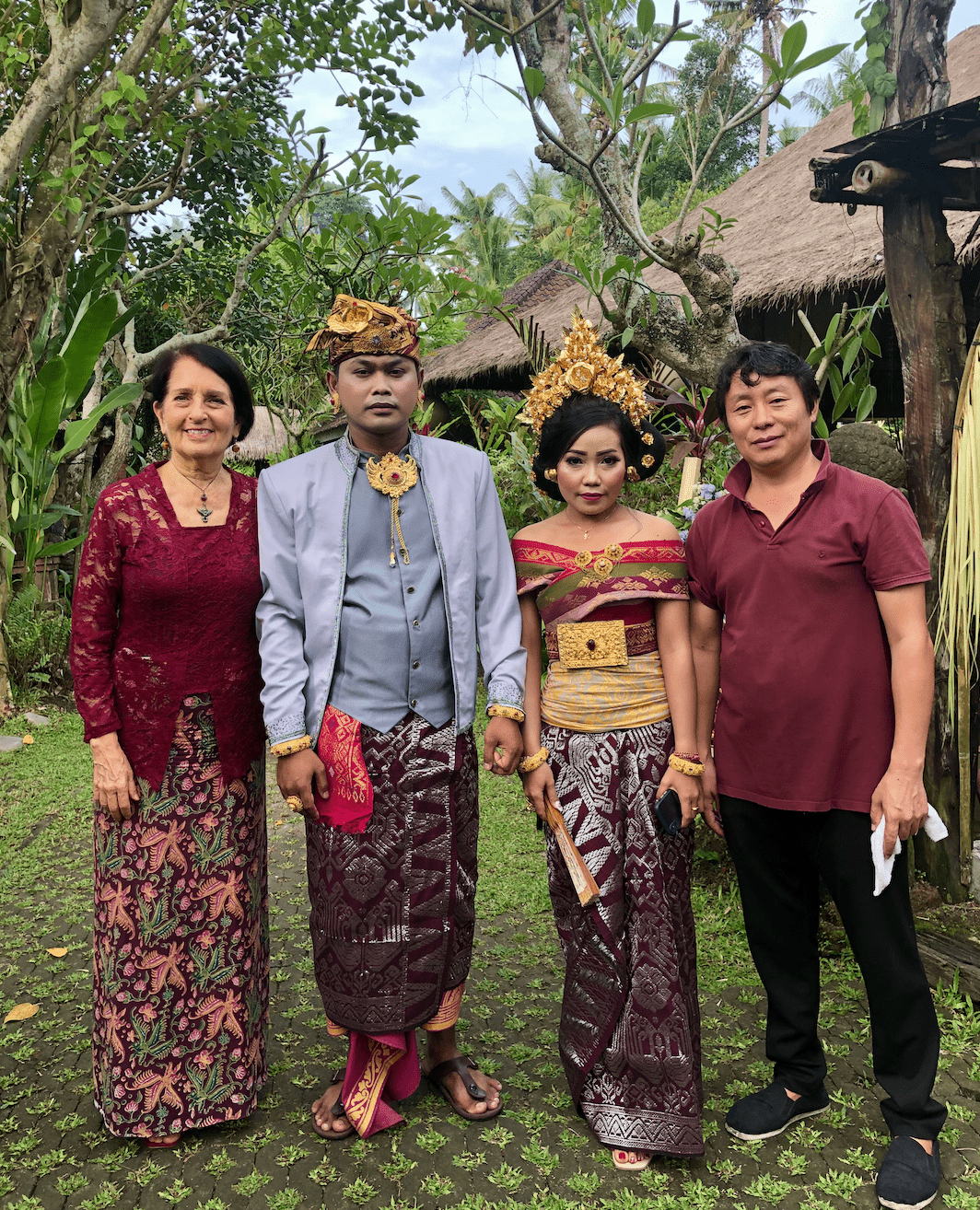
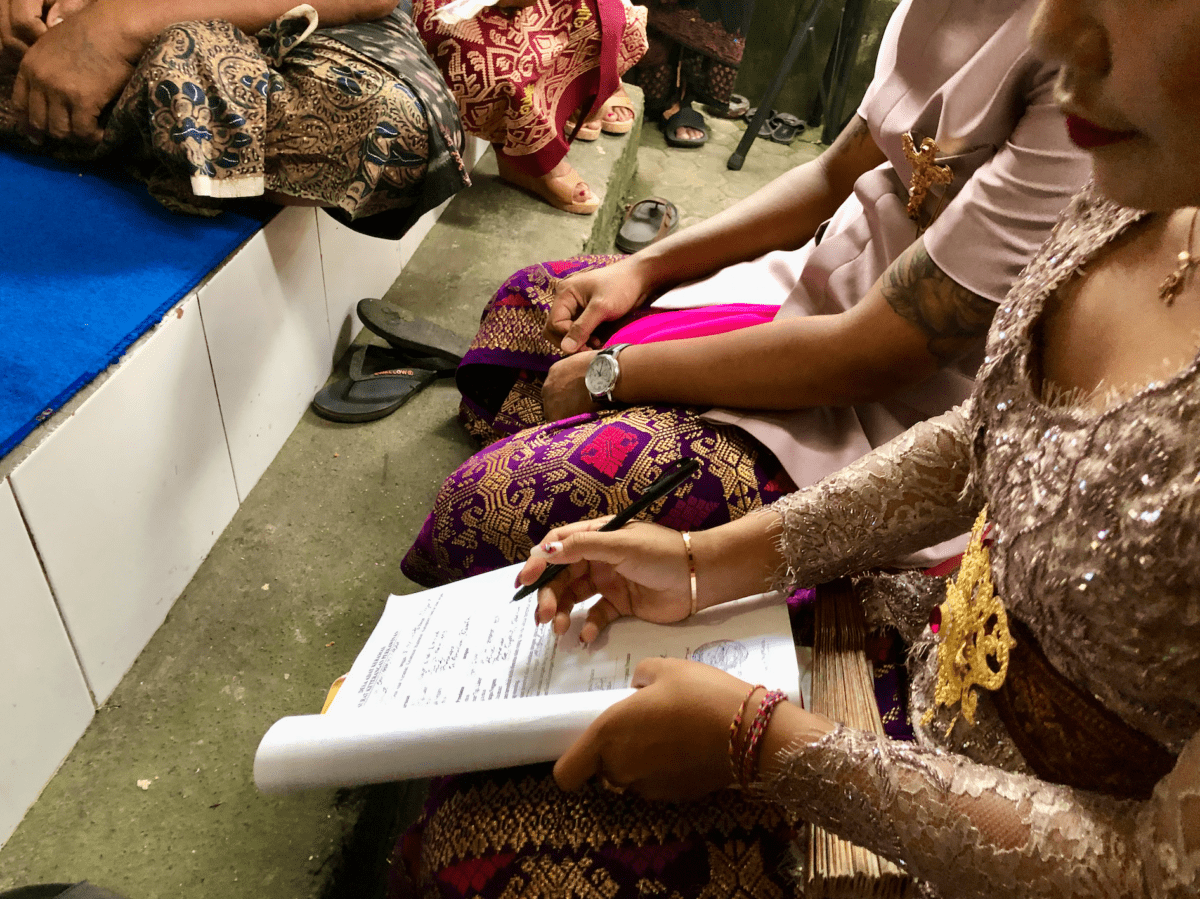
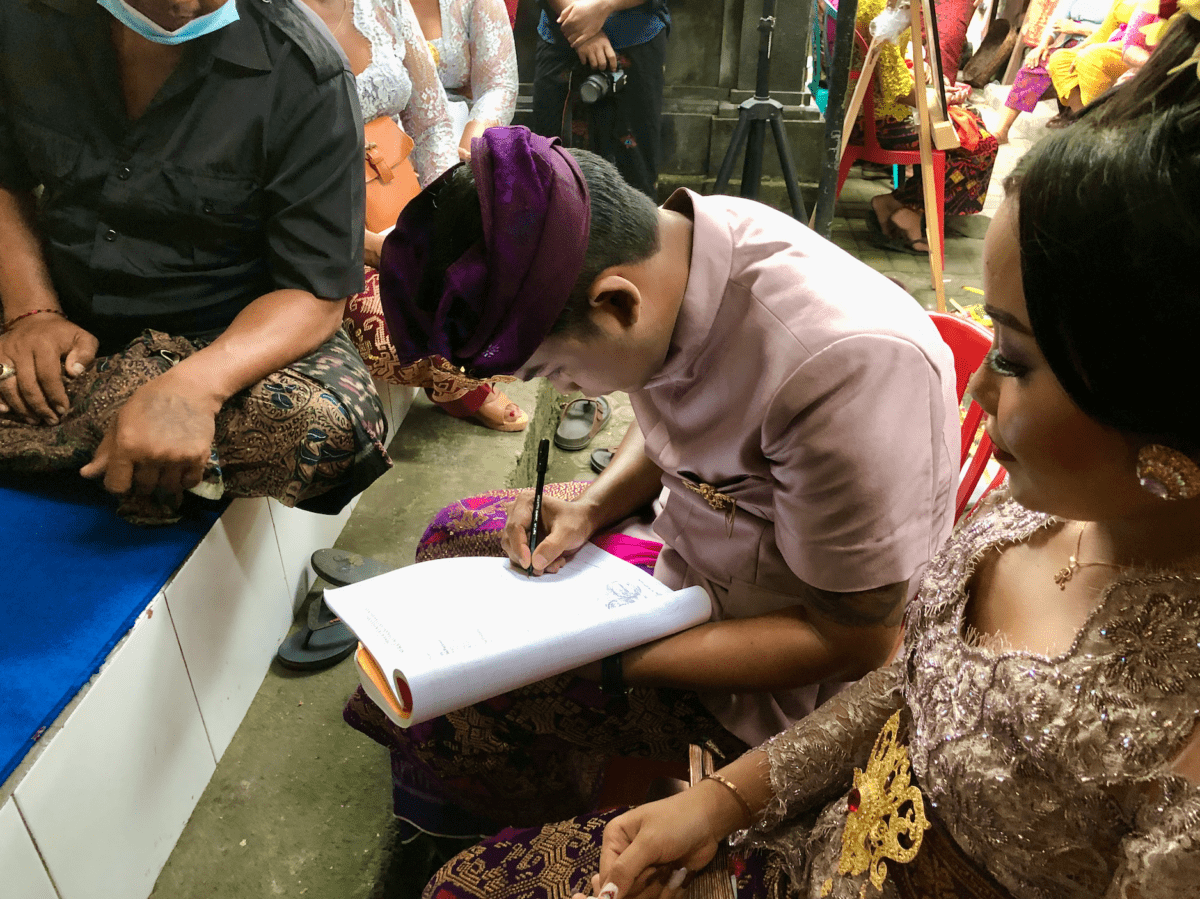
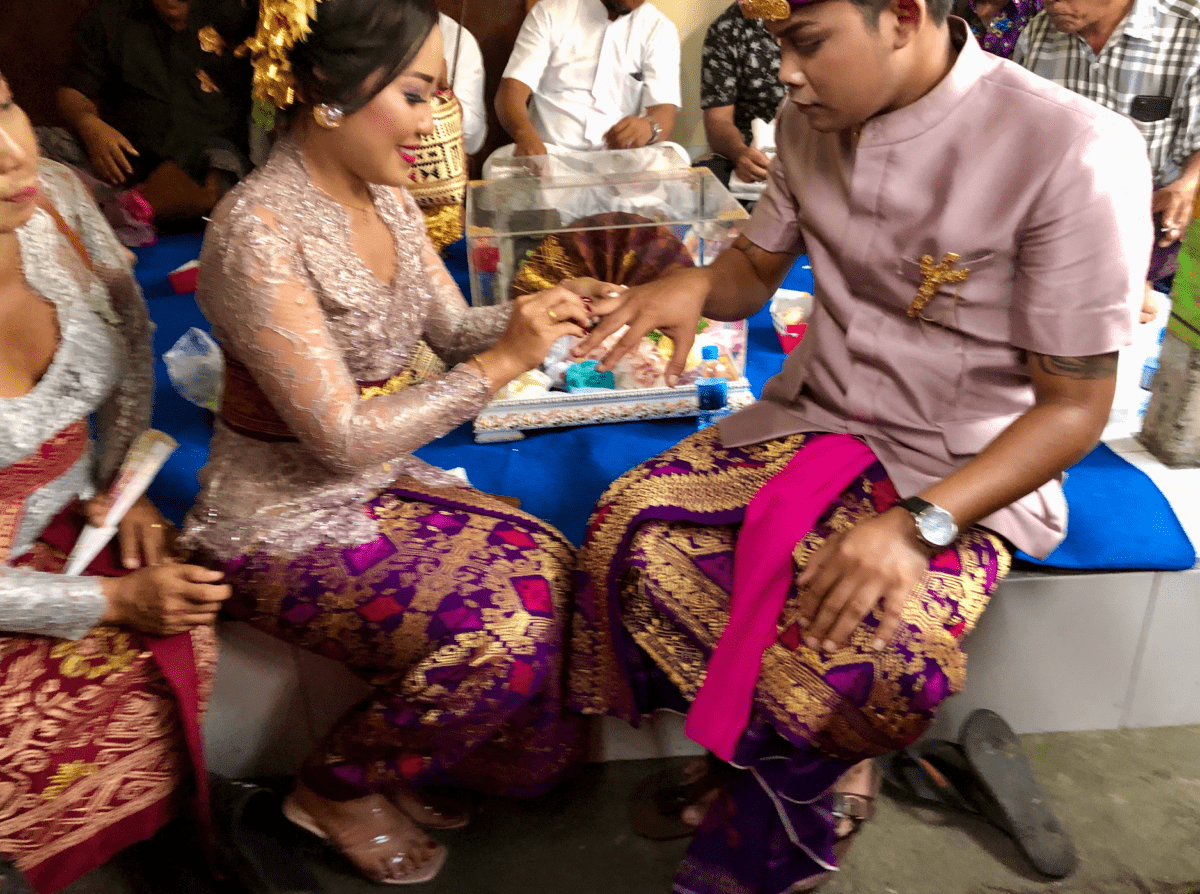
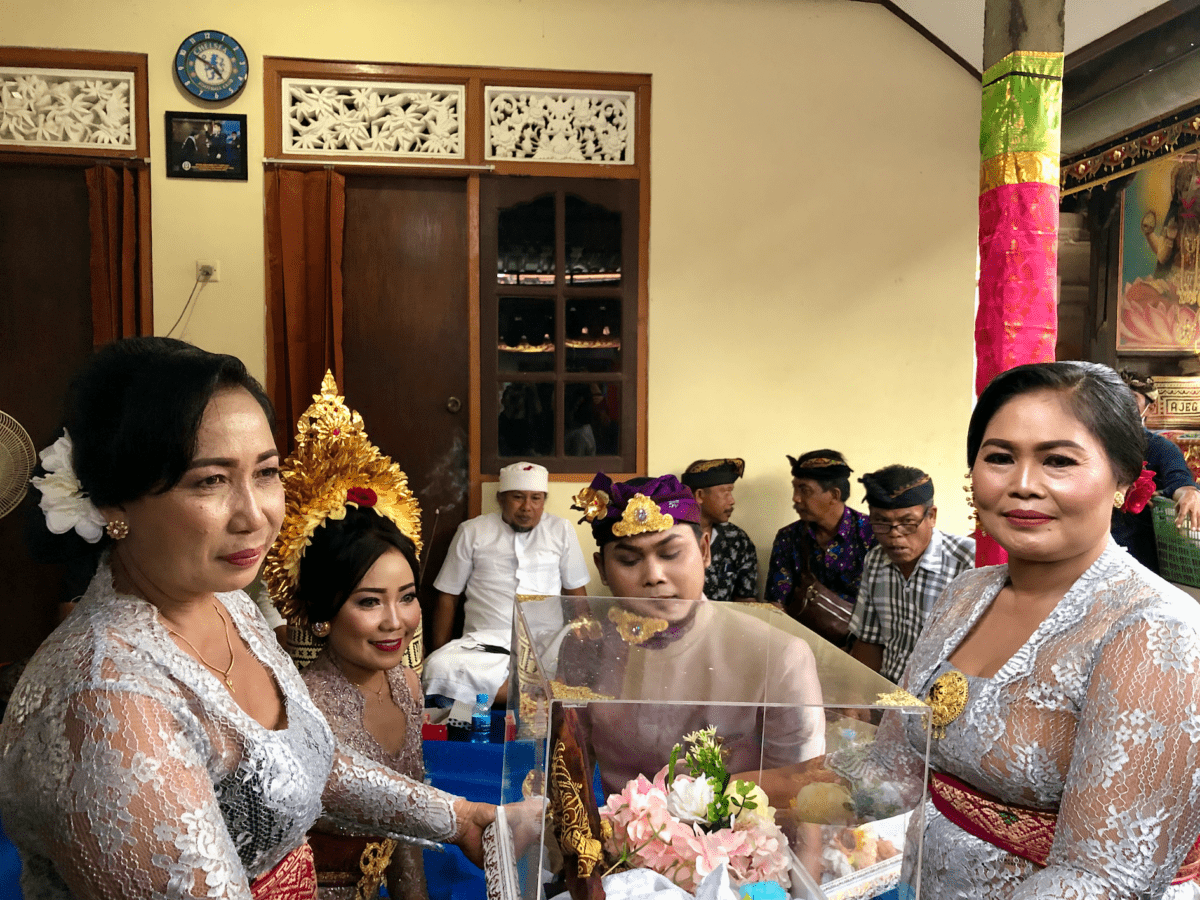
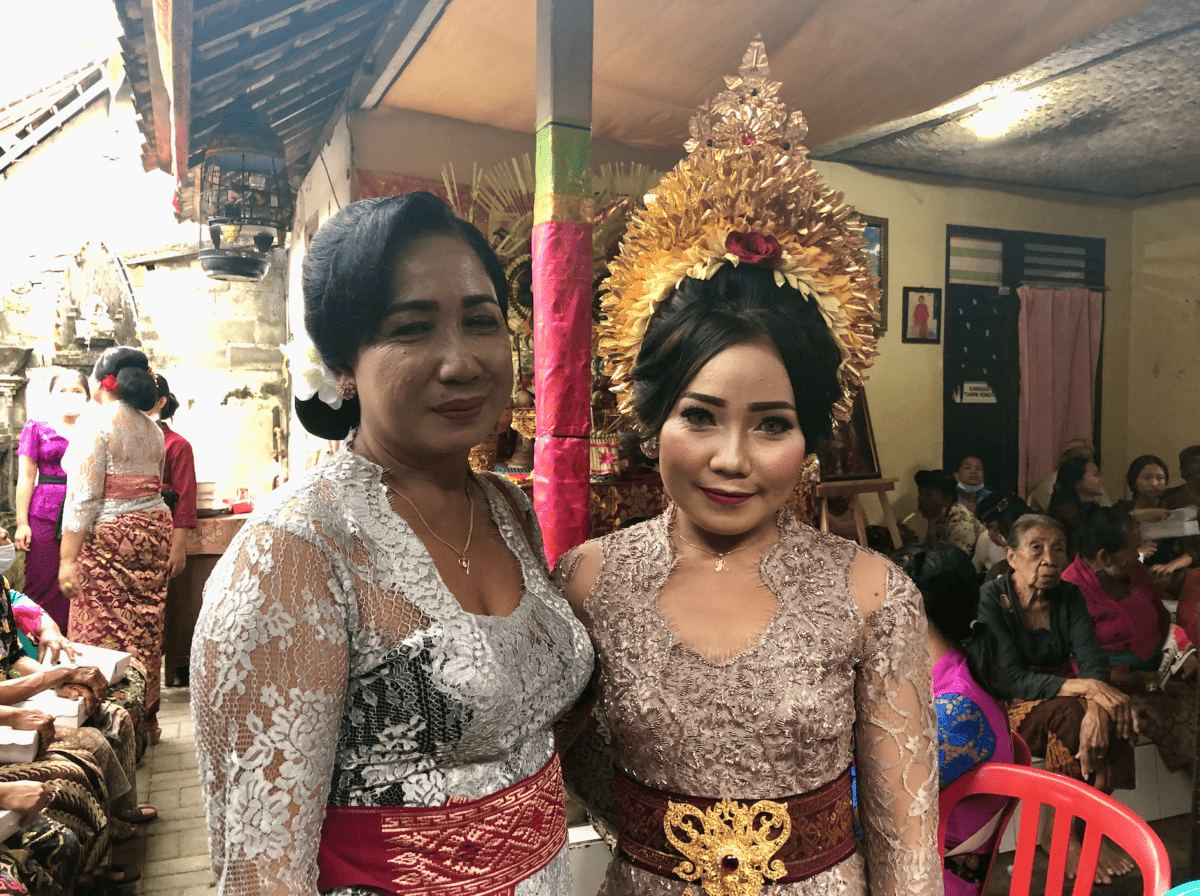

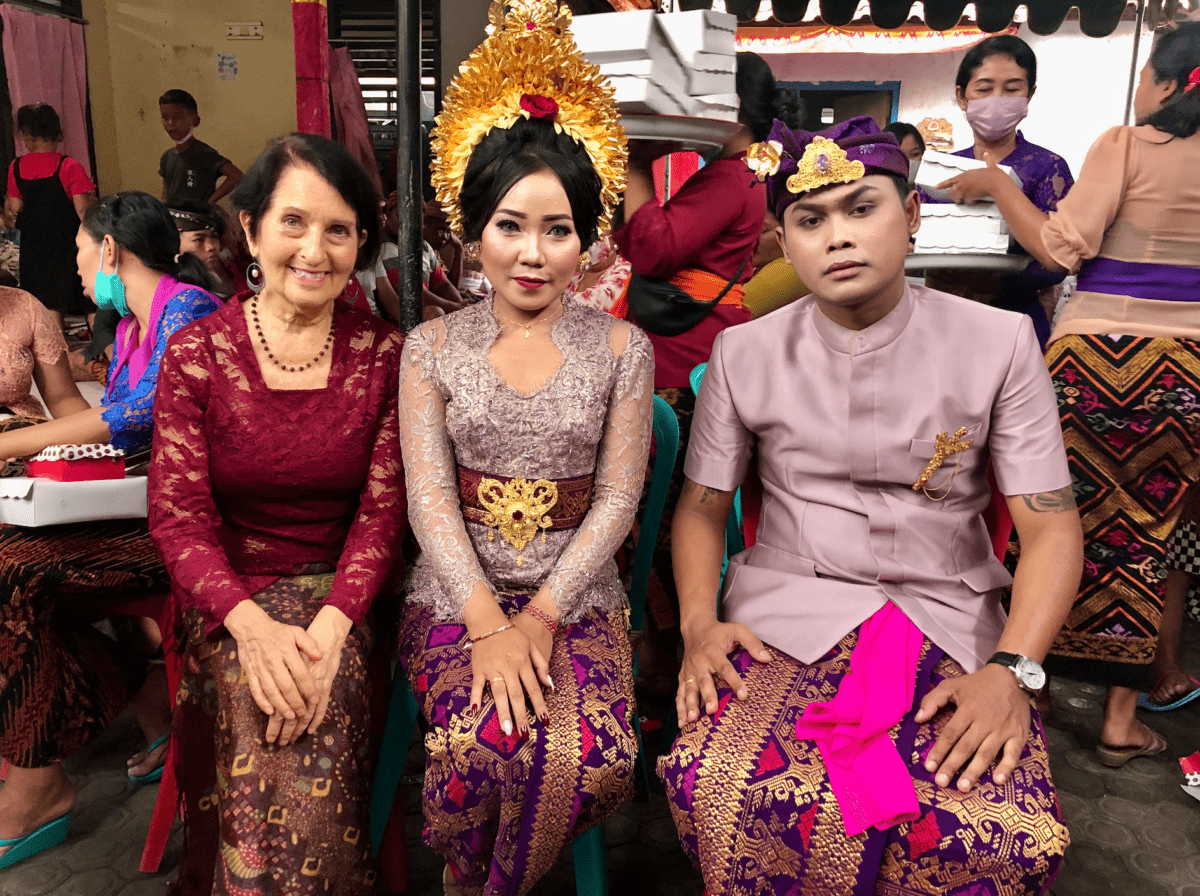
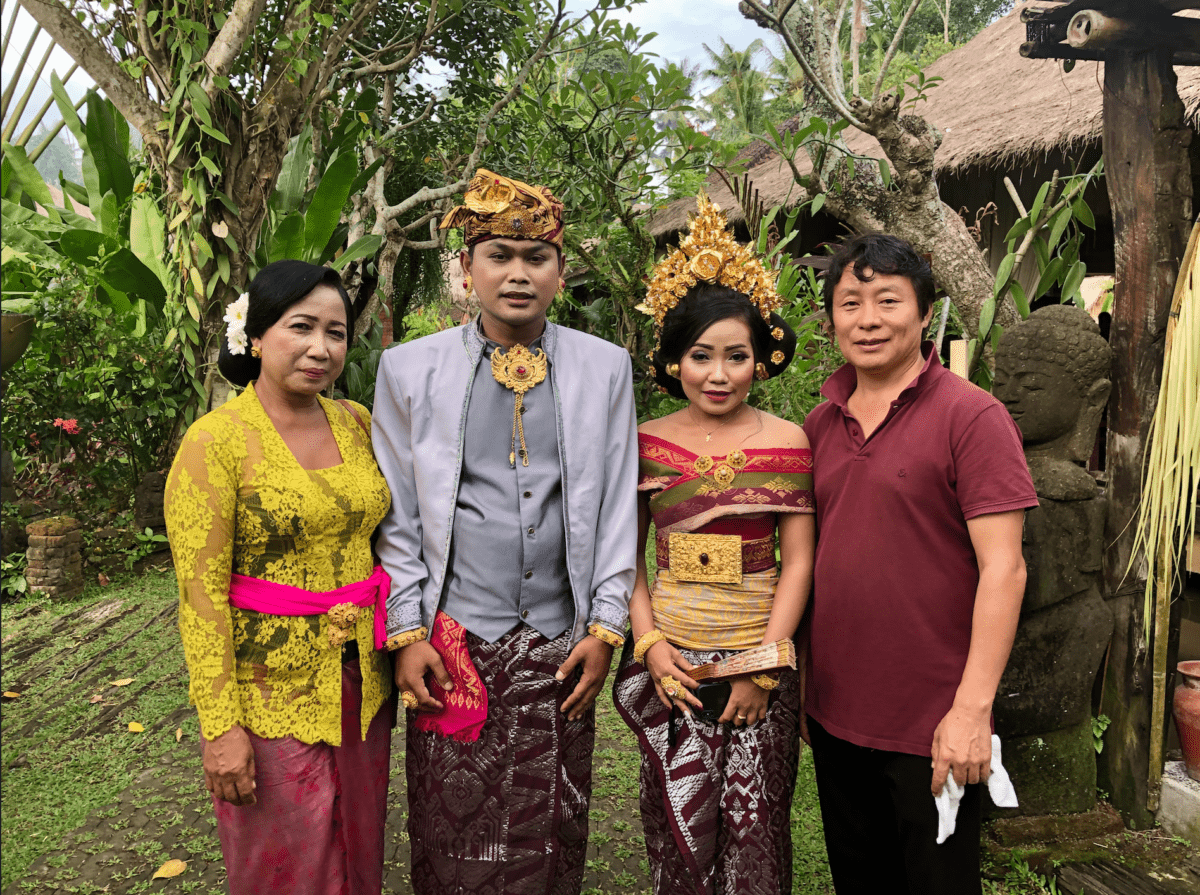
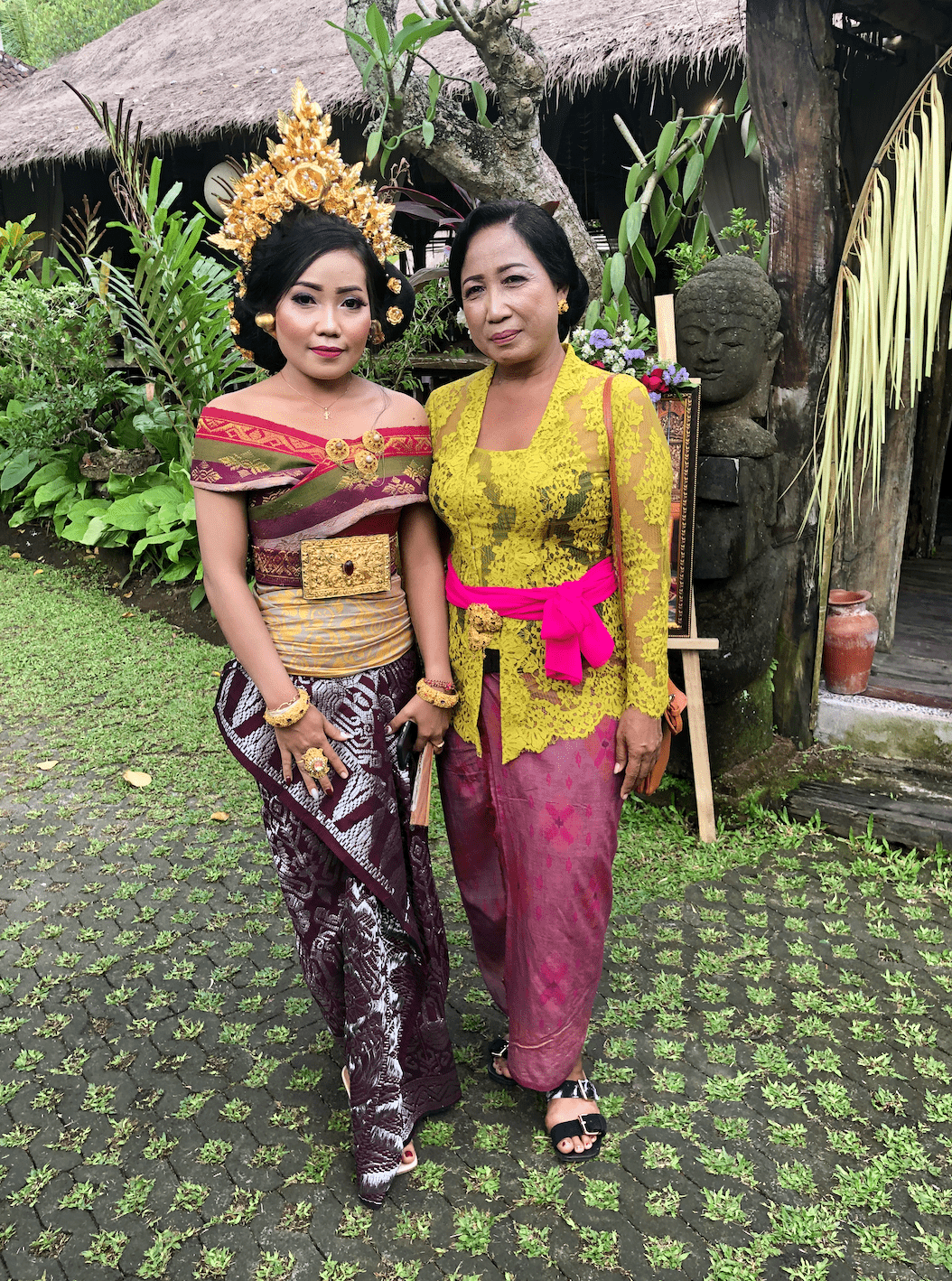
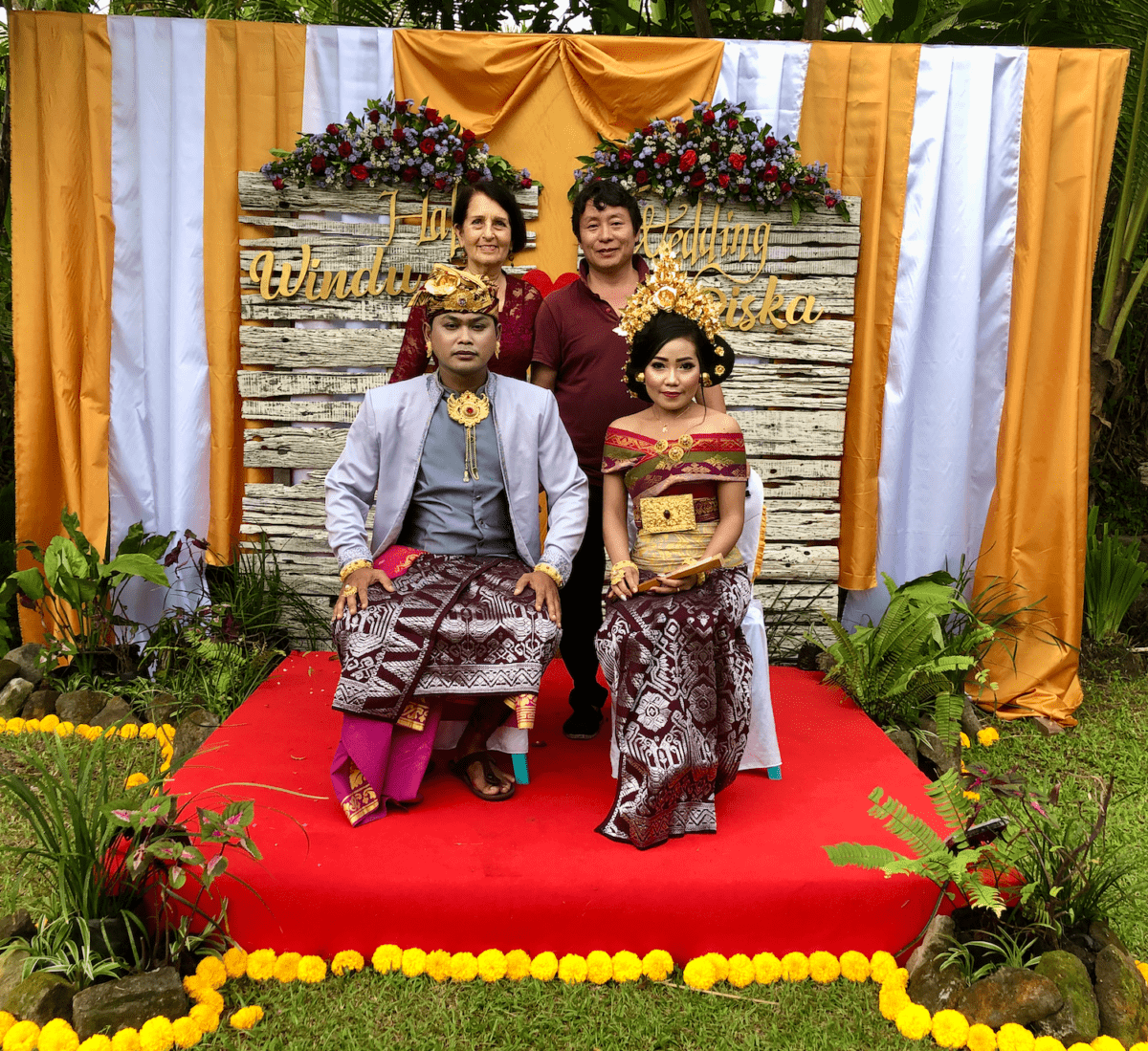
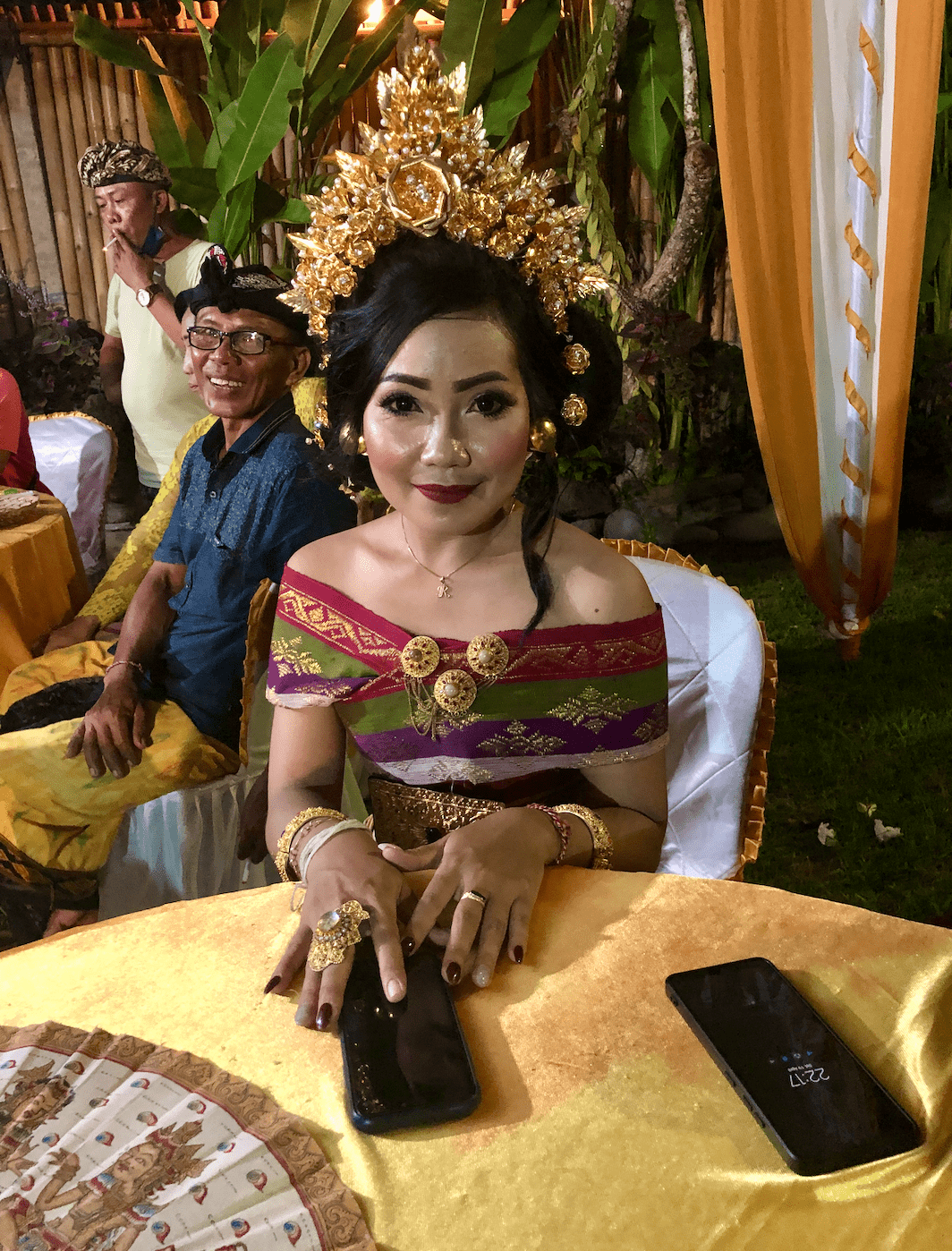

Thanks for watching. It was an amazing week with FIVE weddings. Now all five couples are well situated in their new homes. And they are doing their jobs. We have three babies on the way!


